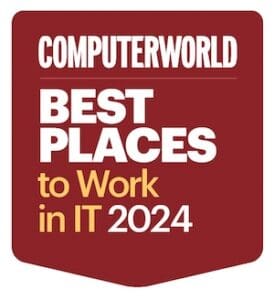All good things must come to an end.
Once shiny and new, desktop machines have now become outdated, bulky, and slow.
The system that once revolutionized your office is now causing more problems than it solves. It has been modified and tinkered with over time, adding additional features not originally designed to handle. Unfortunately, it is not cooperating well with other interconnected systems, causing issues.
It’s time.
Making significant changes to your IT infrastructure requires careful planning and should not be rushed. If you’re considering replacing your current systems and updating your business for the modern era, there are many factors to consider before committing to a long-term solution.
We’ve written this guide to be your friend as you plan for a change.
- How do you determine your needs?
- Who should you involve?
- What haven’t you thought of?
- Where do you even start?
That bit, at least, is easy. You start right here…
Understand. Define. Think ahead
If you are thinking about making a significant investment of your time, money, effort, and headspace, it is important to understand how you arrived at this decision. Is it related solely to IT, or are there other factors, such as process or workflow, hindering your progress? It is also essential to identify any steps in your workflow that exist only as a workaround due to limitations in your current system.
To ensure a successful upgrade, it’s important to clearly define your goals and consider the potential benefits beyond just solving the immediate issue. Take some time to write down how an ideal solution could improve your situation, using “Wouldn’t it be great if…” questions.
Remember that upgrading your IT involves more than simply purchasing a newer, more powerful version of your current system.
It might seem easy, but this situation could also be a chance to synchronize your thoughts with the overall goals of your business. If a department has surpassed an outdated system, consider the possibility of implementing a new solution that can expand as your business grows over the next three to five years. Can multiple databases be combined into a reliable source, enabling all departments to connect and simplify operations?
As time goes by, changes may occur, such as department mergers or office closures. This could lead to more employees working from home and accessing data from various devices and locations. It’s important to consider if your systems can handle the increased amount of data and storage requirements.
Are you considering a move to the cloud?
With modern cloud-based solutions, you only pay for your needed capacity and can quickly scale up as your business grows. This often involves subscribing to Software as a Service (SaaS) or Platform as a Service (PaaS) to reduce in-house management.
However, you must also consider your security and processes, such as communication and information accessibility, to ensure they are secure and efficient in the cloud environment.
What if you go under a bus?
Your end goal might be to exit the company or be less involved in day-to-day operations. So what would happen if you weren’t here? If everything currently falls apart when you’re not around, look at systems and workflows that keep running when you’re not there to sort things out – for any reason.
Keep it simple. Document everything
Businesses often tend to excessively customize their infrastructure, even if it’s unnecessary. While some companies require a fully customized setup, others create overly complex systems to fit new technology into their existing processes. However, modern solutions can provide significant productivity benefits if users are willing to adapt their work methods to optimize their results.
Use this opportunity to build a statement of work. And document everything. This will help save time and resources as you work through any issues and can form the basis of staff training.
Research, research, research
The market offers many possibilities, and the emergence of SaaS (Software as a Service) has only added to the choices available. It can be overwhelming to find the right solution, but seeking expert advice and tapping into your network’s contacts can be extremely helpful. Consider recommendations and consult an IT professional with extensive experience to determine the level of software support and updates, integration with other solutions, and any alternative options you may need to consider.
Most software solutions provide a free trial period, allowing you to test it out and get an idea of the support and communication you will receive before committing long-term. It is important to avoid solutions that fall short of your expectations, as relying on clunky workarounds will only lead you back to square one.
Plan your data migration.
When transitioning from an old system to a new one, it’s crucial to have a plan for transferring your existing data. Simply exporting and importing files may not be enough. Ensure that your backups are secure and have a contingency plan if the implementation process does not go as planned. This will allow you to quickly return to where you were and continue working without delay.
Have an implementation and training plan
To ease the transition to new applications, it’s important to provide training sessions for everyone involved. Resistance to change is natural, so ensuring everyone understands the reasons behind the change is crucial.
Consider hosting on-site training with a professional trainer or utilizing online sessions such as video calls or interactive courses..
Choose the right experts from the get-go.
Whether you know exactly what you need or don’t know where to start, the right experts will support you all the way.
A professional who does this daily won’t see this as the daunting prospect it might feel like to you. They’ll foresee issues before they arise and take the weight of responsibility off your shoulders.
Look for a provider who’s done this before with similar-sized businesses- someone who’ll take the time to understand the customization and personalization required and will think about your overall needs.
And find somebody you like.
Every provider will tell you how great they are, but there may be many ways to answer the same question. So explore your options. Get to know them and ask to speak to their current clients.
If they do a standout job, they could become an IT partner you’ll be working with for a long time. If they leave you feeling let down, you won’t want to work with them again.
If you are considering starting an IT project and need professional advice, contact us first. We specialize in various areas and offer a wide range of solutions. If you would benefit from the expertise of a specialist not on our team, we have access to a network of professionals who can assist you in achieving the best outcome. Don’t hesitate to get in touch with us today.









